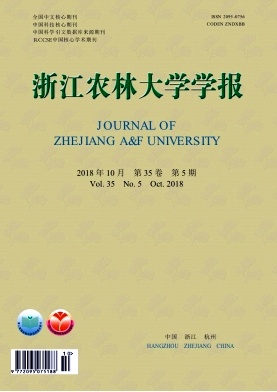-
木材构造特征是木材识别的主要依据[1], 包括宏观构造、微观构造和超微构造, 对木材化学、物理性质有重大影响, 也是木材分类的主要依据, 因此国内外木材研究学者对木材构造特征进行了广泛的研究, 如1992年出版的《中国木材志》收录了528种代表树种的木材构造特征。此后, 又对《中国木材志》未涉及到的部分树种的木材构造特征进行研究[2-3]。挥发性有机物成分是指植物通过次生代谢所产生的产物[4], 与植物对环境的适应能力[5]及其抵抗不利条件[6]密切相关, 其药用和生态价值极高。如萜类化合物[7-8]通常具有调节神经系统、镇静大脑、抗菌消炎和净化空气等作用。吴楚材等[9]从植物体中采集挥发性气体进行化学成分研究。近年来随着气相色谱-质谱联用(GC-MS)技术的发展, 对木材挥发物的研究逐渐增多, 如孙继平等[10]探讨了2种肤小蠹Phloeosinus对几种针叶树挥发物的行为反应; 徐磊等[11]分析了5种针叶树球果所含挥发性物质与丽江球果花蝇Strobilomyia lijiangensis危害关系; 李阳等[12]测定分析了4种樟科Lauraceae园林树种挥发性物质的有效成分及其杀菌能力。黑壳楠Lindera megaphylla为樟科山胡椒属Lindera多年生常绿乔木, 观赏性强, 抗逆性好, 分布范围广, 枝、果、叶所含芳香油具备杀菌、驱虫和净化空气等功效, 是一种集观赏、生态和药用于一体的优质园林树种[13-14]。中国民间用其抽提物抗肿瘤和愈合伤口, 用其根治风湿麻木、胃寒气滞, 用其树皮治疗咽喉肿痛、湿疹瘙痒、外伤出血等[15]。卞京军等[16]研究了黑壳楠树叶精油的有机物成分, 分离鉴定出有机物成分87种。国外日本学者从黑壳楠的根中提取出d-荷苞牡丹碱(d-dicentrine), 发现它具有抗肿瘤作用[17], 同时还从花和花梗中分离出6个阿朴菲型生物碱[18]和1个新异喹啉生物碱[19]。未检索到国内外关于其木质部挥发性有机物成分的研究报道。另外, 木材构造特征作为区分黑壳楠木材与其他木材的重要理论依据, 也未见报道。因此本研究拟通过研究黑壳楠木材的构造特征, 以期为区分黑壳楠与其他木材提供重要的理论依据, 并采用GC-MS技术分析黑壳楠木材挥发性有机物成分的主要组分, 为科学评定和深层次开发利用黑壳楠资源提供科学依据。
HTML
-
所选黑壳楠活立木树龄约100 a, 胸径为1.79 m, 直径为0.54 m, 取样处离地高度1.3 m, 沿树干东、西、南、北4个方向用树木生长锥(长500 mm, 直径5.15 mm)钻取4根木芯样(钻取至树干髓心), 用密封袋密封处理(标记东、南、西、北方向)后, 带回实验室。取样点位于四川省雅安市云峰寺后山, 海拔为1 024.2 m, 29°76′N, 102°87′E; 东邻成都平原, 西接青藏高原, 地处高原东南麓陡峭坡地边缘; 气候类型是以亚热带季风气候为基带的山地气候, 气候温和, 雨量充沛; 1961-2010年雅安市年平均气温为16.2 ℃, 年平均降水量为1 270.9 mm[20]。
-
取南、北向木芯样, 砂纸打磨后, 分别在肉眼、放大镜和手持显微镜下观察黑壳楠木芯样生长轮、管孔、轴向薄壁组织、木射线、纹理、构造等宏观特征。标记南、北向木芯样的生长轮, 以每20轮龄为梯度截断木芯样, 取经过编号的5支试管, 分别盛少量蒸馏水, 加入5段截断后的木芯样, 置入水浴锅内蒸煮至木材软化, 软化后的木材用TU-231大型滑走式切片机切片, 参照《木材鉴别方法通则》[21]制片, 风干后放在OLYMPUS BX51光学显微镜下观察其微观构造并拍摄照片; 用冰醋酸-过氧化氢法进行离析, 并制备临时性试片, 在显微镜下拍摄图片, 利用计算机图像测量分析系统测量木材的构造特征参数和组织比量, 并利用JSM-6490LV扫描电子显微镜观察黑壳楠木材超微观构造特征, 补充完善其微观构造特征。
-
取黑壳楠东、西向木芯样, 粉碎, 取≤30目的样品(4.0 ± 0.1) g置于萃取瓶中, 将固相微萃取手柄插入瓶中, 伸出萃取头, 在85 ℃下(能够最大限度检测其挥发性有机物成分化学成分的最佳温度)保温40 min; 退回萃取头, 拔出SPME手柄, 得其挥发性有机物成分样品。解析时间为3 min。将挥发性有机物成分经过GC-MS分析后, 把分离化合物质谱数据经计算机检索与质谱库相匹配, 并以人工解析为辅, 利用色谱峰面积归一化法计算各化学成分的相对百分含量。①色谱条件:HP-INNOWax毛细管色谱柱(柱长30 m, 内径0.25 mm, 膜厚0.25 um); 进样量为1 μL, 分流比50:1;进样口温度为250 ℃; 载气为高纯氦气; 柱温箱升温程序:120 ℃保持3 min, 以5 ℃·min-1速率升温到140 ℃保持4 min, 以2 ℃·min-1速率升温到160 ℃保持10 min; 流速:1 mL·min-1[22]。②质谱条件:离子源为EI, 电离能70 eV, 辅助加热区为280 ℃, 离子源230 ℃, 四级杆150 ℃, 采集模式为全扫描, 质量扫描范围50~550, 溶剂延迟3 min[22]。
1.1. 材料
1.2. 实验方法
1.2.1. 木材构造特征研究方法
1.2.2. 挥发性有机物成分研究方法
-
黑壳楠树皮灰褐色至灰黑色, 木材呈黄白色或浅灰绿色, 心边材区分不明显; 木材表面有较弱光泽; 气微香, 味略辛; 木材纹理直至斜, 木材构造细腻且均匀; 生长轮不明显至略明显; 心材轮间细线颜色较边材轮间细线颜色深; 散生; 宽度较均匀, 3~8轮·cm-1; 横切面上管孔肉眼下略可见, 放大镜下明晰, 大小略一致, 分布均匀, 散生; 管孔内少见侵填体; 轴向薄壁组织放大镜下可见, 稀疏傍管状; 横切面上木射线在肉眼下可见至不可见, 在放大镜下明显, 比管孔小。在放大镜下弦切面木射线明显, 径切面上射线斑纹明显。波痕及胞间道缺如。
-
如图 1所示:导管横切面为圆形或卵圆形, 部分略具多角形轮廓; 管孔数少[23], 9~13个·mm-2, 平均为11个·mm-2; 管孔组合以单管孔和短径列(2~3个)复管孔为主, 偶见短弦列(2个)复管孔和管孔团; 散孔材; 管孔中[23], 最大弦径≥150 μm, 多数为90~110 μm, 平均为102 μm; 导管分子长255~596 μm, 平均446 μm, 导管长度属于中级别[23]; 导管细胞壁厚, 为7.5 μm; 导管细胞端部的穿孔类型为单穿孔, 穿孔板水平至略倾斜; 相邻导管间细胞壁上纹孔的排列形式为互列纹孔; 导管-射线间纹孔式为同管间纹孔式和大圆形; 纹孔口内含, 卵圆形及圆形; 轴向薄壁组织量少, 傍管形稀疏状为主, 可见环管状; 边材侵填体少见, 心材侵填体较边材多; 横切面上木纤维细胞壁较薄, 壁厚为3.7 μm, 直径多为20~26 μm, 平均23 μm, 长740~1 450 μm, 平均1 110 μm, 与邓恩桉Eucalyptus dunni木材纤维[24]同属中等木纤维[23]; 形状大多呈扁圆形、多角形; 弦向腔径略大于径向; 细胞沿径向排列整齐有序, 弦向上呈交错排列, 较松散; 木射线非叠生, 稀少[23], 5 mm内25~32条, 平均28条; 单列射线极少, 宽15~25 μm, 高36~312 μm(2~7个细胞); 多列射线宽度细至中[23], 宽32~68 μm(2~3个细胞), 高136~864 μm(3~31个细胞); 同一射线内间或出现2次多列部分; 射线组织异型Ⅲ型和Ⅱ型; 油细胞未见; 树胶及晶体未见; 螺纹加厚缺如; 胞间道缺如。
组织比量是衡量木材材性的重要参数, 与木材物理性质、力学性质和化学性质都有着密切的关系[24]。黑壳楠木纤维的组织比量为52.7%, 占整个组织的1/2以上; 木射线的组织比量为24.6%;导管的组织比量为13.2%;轴向薄壁组织的组织比量为9.5%。
-
由图 2可知:导管上的纹孔为互列纹孔, 射线与导管间纹孔式为同管间纹孔式和大圆形; 木射线细胞中可见球状物和块状物(图 2C), 通过能量色散分析仪(EDS)分析, 块状物的主要成分有钙、碳、氧, 球状物的主要成分为碳、氧(表 1), 初步预测木射线块状物可能是含钙有机物形成的结晶体, 木射线中球状物可能并非无机盐类, 而是树胶类物质, SCURFIELD等[25]将此类物质认定为淀粉颗粒。
元素 块状物 球状物 质量百分比/% 原子百分比/% 质量百分比/% 原子百分比/% 碳 16.61 32.55 57.26 64.09 氧 20.90 30.75 42.74 35.91 钙 62.49 36.70 Table 1. Block and globular material composition in wood ray
-
通过GC-MS分析, 得到黑壳楠木材挥发性有机物成分总离子流图(图 3), 共分离出39个峰, 参照质谱的裂解规律, 将质谱数据经计算机检索与质谱库检索和分析, 并以人工解析为辅, 共鉴定出23种化合物(表 2), 占总化学成分的87.11 %, 主要为烃类化合物及其含氧衍生物。
序号 t/min 化合物 分子式 分子量 相对含量/% 类别 1 8.97 α-荜澄茄油烯 .alpha.-cubebene C15H24 204 0.85 烯烃 alkenes * 2 9.33 δ-榄香烯 .delta.-elemene C15H24 204 0.36 烯烃 alkenes * 3 9.83 α-可巴烯 .alpha.-copaene C15H4 204 0.90 烯烃 alkenes * 4 10.49 (1s,7r)-1,4, 4, 7-四甲基-1,4, 5, 6, 7, 8-六氢-2(3h)-萘酮 (1s,7r)-1,4, 4, 7-tetramethyl-1, 4, 5, 6, 7, 8-hexahydro-2(3h)-naphtalenone C14H22O 206 3.74 酮 ketone 5 10.93 4, 7-二甲基-1-异丙基全氢萘 4, 7-dimethyl-1-isopropyl perhy-dronaphthalene C15H28 208 22.46 环院烃 cycloparaffin 6 11.45 α-柏木烯 .alpha.-cedrene C15H24 204 2.04 烯烃 alkenes * 7 12.44 3, 7愈创木二烯 3, 7-guaiadiene C15H24 204 20.11 烯烃 alkenes * 8 12.74 香树烯 1h-cycloprop [e] azulene, decahydro-1, 1, 7-trimethyl-4-methylene-, [1ar-(1aa, 4ab, 7b, 7ab, 7ba)]- C15H24 204 1.00 烯烃 alkenes * 9 14.21 α-紫穗槐烯 .alpha.-amorphene C15H24 204 5.89 烯烃 alkenes * 10 15.68 δ-荜澄茄烯 .delta.-cadinene C15H24 204 0.80 烯烃 alkenes * 11 16.06 芳-香姜黄烯 ar-curcumene C15H22 202 2.23 烯烃 alkenes * 12 17.37 1s, 顺去氢白菖烯 1s, cis-calamenene C15H22 202 12.05 烯烃 alkenes * 13 18.76 3-[(3e)-4, 8-二甲基-3, 7-壬二烯]呋喃3-[(3e)-4, 8-dimethylnona-3, 7-dienyl] furan C15H22O 218 0.84 呋喃 furan * 14 19.30 去二氢菖蒲烯 calacorene C15H20 200 1.38 烯烃 alkenes 15 20.32 α-二去氢菖蒲烯 .alpha.-calacorene C15H20 200 0.57 烯烃 alkenes 16 20.87 石竹烯环氧化物 caryophyllene oxide C15H24 220 0.88 氧化物 oxide * 17 23.58 异构吉马酮环氧化物 isogermacrone-epoxide C15H22O2 234 3.09 氧化物 oxide * 18 23.89 γ-按叶醇 .gamma. - eudesmol C15H26O 222 0.53 醇类 alcohols * 19 25.80 沉香螺旋醇 agaruspirol C15H26O 222 1.58 醇类 alcohols * 20 26.79 呋喃,3-甲基-2-[3-甲基-4-(4-甲基-2-呋喃基)-2-丁烯基]-,(e)-furan, 3-methyl-2- [3-methyl-4-(4-methyl-2-furanyl)-2-butenyl] -, (e)- C15H18O2 230 1.39 呋喃 furan * 21 27.04 愈创木奠1, 4-dimethyl-7 - (1 -methylethyl) -azulene C15H18 198 3.26 奠 azulene * 22 31.75 愈创蓝油烃 guaiazulene C15H18 198 0.83 奠 azulene * 23 34.67 亚油酸乙酷 ethyl linoleate C20H36O2 308 0.35 酯 ester 说明:*表示倍半萜化合物 Table 2. Volatile organic compounds of Lindera megaphylla wood
黑壳楠木材挥发性有机物成分中相对含量超过1%的成分共有13种, 占总峰面积的80.22%, 其中相对含量最高的化合物为4, 7-二甲基-1-异丙基全氢萘(22.46%), 其次为3, 7-愈创木二烯(20.11%), 1s, 顺去氢白菖烯(12.05%), α-紫穗槐烯(5.89%), (1s, 7r)-1, 4, 4, 7-四甲基-1, 4, 5, 6, 7, 8-六氢-2(3H)-萘酮(3.74%), 愈创木薁(3.26%), 异构吉马酮环氧化物(3.09%), 芳-香姜黄烯(2.23%), α-柏木烯(2.04%), 沉香螺旋醇(1.58%), 呋喃, 3-甲基-2-[3-甲基-4-(4-甲基-2-呋喃基)-2-丁烯基]-, (E)-(1.39%), 去二氢菖蒲烯(1.38%)和(+)-香橙烯(1.00%)。由表 3可知:黑壳楠木材挥发性成分中相对含量最高的是烯烃类化合物(48.18%), 其化合物种类最多, 共12种。
成分类别 数量/种 相对含量/% 烯烃类 12 48.18 环院烃 1 22.46 奠类 2 4.09 酮类 1 3.74 氧化物 2 3.62 呋喃类 2 2.23 醇类 2 2.11 酯类 1 0.35 Table 3. Volatile organic compounds of L.megaphylla wood
黑壳楠木材挥发性有机物成分主要含萜类化合物, 有18种萜类化合物, 均为倍半萜化合物, 累计相对含量高达58.63%。其中烯类化合物10种, 累计相对含量高达46.23%;醇类化合物2种, 累计相对含量达2.11%;酮类化合物有1种, 累计相对含量高达3.09%;呋喃类化合物有2种, 累计相对含量达2.23%;薁类衍生物2种, 累计相对含量达4.09%;倍半萜含氧衍生物2种, 累计相对含量达3.97%。相对含量超过1%的倍半萜类成分10种, 累计相对含量为52.64%, 包括3, 7-愈创木二烯(20.11%), 1s, 顺去氢白菖烯(12.05%), α-紫穗槐烯(5.89%), 愈创木薁(3.26%), 异构吉马酮环氧化物(3.09%), 芳-香姜黄烯(2.23%), α-柏木烯(2.04%), 沉香螺旋醇(1.58%), 呋喃, 3-甲基-2-[3-甲基-4-(4-甲基-2-呋喃基)-2-丁烯基]-, (E)-(1.39%)和(+)-香橙烯(1.00%)。
2.1. 宏观构造特征
2.2. 微观构造特征及其组织比量
2.3. 微观形貌与成分分析
2.4. 挥发性有机物成分分析
-
黑壳楠木材构造特征为散孔材, 木射线及导管肉眼下可见; 木射线非叠生, 每5 mm内有25~32条, 平均28条; 单列射线极少, 宽15~25 μm, 高36~312 μm(2~7个细胞); 多列射线宽度细至中, 宽32~68 μm(2~3个细胞), 高136~864 μm(3~31个细胞); 同一射线内间或出现2次多列部分; 射线组织异型Ⅲ型和Ⅱ型。导管横切面为圆形或卵圆形, 部分略具多角形轮廓, 单位面积管孔数少, 管孔组合以单管孔和短径列(2~3个)复管孔为主, 偶见短弦列(2个)复管孔和管孔团, 最大弦径≥150 μm, 多数90~110 μm, 平均102 μm; 导管分子长255~596 μm, 平均446 μm; 横切面上木纤维细胞壁较薄, 壁厚为3.7 μm; 直径多为20~26 μm, 平均23 μm; 长740~1 450 μm, 平均1 110 μm; 轴向薄壁组织以傍管形稀疏状为主, 可见环管状; 导管细胞端部的穿孔类型为单穿孔, 穿孔板水平至倾斜; 相邻导管间细胞壁上纹孔的排列形式为互列纹孔, 导管-射线间纹孔式为同管间纹孔; 纹孔口内含, 卵圆形及圆形; 油细胞未见。木射线细胞中的球状物可能是含钙有机物形成的结晶体; 木射线中块状物可能并非无机盐类, 而是树胶类物质。黑壳楠木纤维的组织比量为52.7%, 占整个组织的1/2以上; 木射线的组织比量为24.6%;导管的组织比量为13.2%;轴向薄壁组织的组织比量为9.5%。黑壳楠木材的宏微观特征可作为区分于其他木种的理论依据之一。
黑壳楠木材挥发性有机物成分中鉴定出的23种化合物, 其相对含量之和占总化学成分的87.11%, 主要为烃类化合物及其含氧衍生物; 挥发性有机物成分中相对含量超过1%的成分共有13种, 占总峰面积的80.22%;挥发性有机物成分主含萜类化合物, 有18种萜类化合物, 均为倍半萜化合物, 累计相对含量高达58.63%。
从生源来看, 1s, 顺去氢白菖烯、去二氢菖蒲烯、α-二去氢菖蒲烯属菖蒲烷型来源于没药烷型倍半萜类; 3, 7-愈创木二烯、愈创木薁、愈创蓝油烃属愈创木烷型来源于吉马烷类的倍半萜。通常, 没药烷型倍半萜类衍生物具有显著抗乙肝病毒活性及抗肿瘤的功效[26]。研究表明:萜类化合物多有芳香气味, 通常具有提神、抗菌消炎和镇痛等作用, 具有多种生物活性, 是许多药物的有效成分, 可以治疗疾病, 如调节血糖浓度、降低血脂和血压; 杀虫、杀菌、活血化淤、消炎镇痛消肿、抗肿瘤、抗疟、抗人类免疫缺陷病毒(HIV); 强化免疫; 局部麻醉、止痒; 解热、祛痰、止咳等[27]。例如, 沉香螺旋醇具有镇静催眠作用[28]; 去氢白菖烯被认为是强效的抗菌和抗肿瘤剂[29]; 石竹烯环氧化物具有抗菌消炎和抗真菌等活性, 具有平喘作用, 乙酸己酯不仅能够镇痛抗炎, 还可以愉悦心情, 同时也是食用添加香料[30-31]; 榄香烯是一种广谱、高效的抗肿瘤药物, δ-榄香烯可诱导Hela细胞凋亡[32]; γ-桉叶醇是沉香的主要成分之一, 同时也是蜂胶的主要成分之一[33]; 《抗病毒中药学》提到荔枝核主治行气散结、散寒止痛, 水提物能完全抑制乙型肝炎病毒病毒的复制, 是乙型肝炎病毒复制的高效抑制剂, 其主要成分在黑壳楠木材挥发性有机物成分中有7种, 累计相对含量达22.13%。这表明黑壳楠木材有较高的医药利用价值。
愈创木薁为美国化妆品协会(CTFA)认可的化妆品助剂, 具有抗炎, 抗过敏的作用, 在防晒制品中用于预防或治疗阳光灼伤, 缓解其他物质对皮肤的刺激和过敏反应, 为常见的外用抗过敏剂[34]。α-荜澄茄油烯是目前香料工业的重要原料, 也是柏木精油的3种主要成分之一[35]。这表明黑壳楠木材作为芳香理疗产品具有极大的应用潜力。










 DownLoad:
DownLoad:

